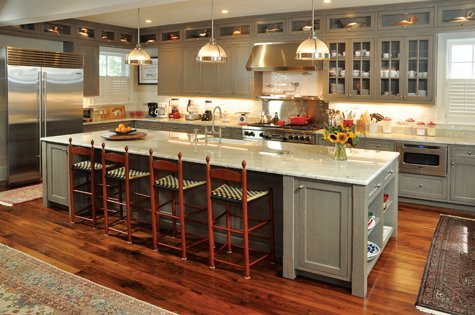HOME PORTRAIT

From Inn to Private Home Again
Designer Julie Robinson Revives and Edgartown Classic in Stately Fashion
By Amelia Smith
A few years ago, Julie Robinson was hired to help transform the Shiverick Inn back into a private home. The project started out as a minor renovation and redecoration but became an overhaul of the entire property. Julie worked with the owner and his family to create a space particularly suited to them which also celebrated the house’s past and preserved its traditional style. She combined most of the existing furnishings and features with comple-mentary pieces gathered from near and far.
“I think what I enjoyed most about this project was working with the builders to make sure everything was just right,” Julie says. “Going into a house there are things that a woman sees that a man doesn’t notice; women are usually the ones doing the work in the space.”
It was not the home’s first renovation. The building’s namesake, Dr. Clement F. Shiverick, moved to Edgartown in 1850 to practice medicine. He died in 1857 at the age of 38, leaving behind a widow and three young children. His widow, Mary, had an ample trust fund that allowed her to spend her winters in the South. Inspired by the southern houses she enjoyed in the winter, she decided to completely reconfigure the house in 1875.
The original house was a relatively modest building with its gable end facing the road and a long porch along the lane at one side. The widow Shiverick called in carpenters and movers to pick up the front part of the house and turn it ninety degrees, leaving the kitchen and doctor’s office where they were, at the back of the building. She then added another twelve feet to the new front and put on a third story with a French, or mansard, roof and an enclosed widow’s walk.
That renovation was the subject of a 1933 article written by her daughter, Anna (Shiverick) Nevin, wife of Dr. William C. Nevin. By then, the house had had three different kitchens, each quite different from the last. The doctor’s office moved to the front of the house, facing Pease’s Point Way, while the rest of the building was the Nevin family house. The doctor started off treating animals as well as human patients, but when there were too many animals, he brought the first veterinarian here, as well as the first psychiatrist, Dr. Milton Mazer. Later, the house became an inn and remained so until the current owners bought it and began to make it their own.
The purchase included all of the Shiverick Inn’s furnishings; antique bedsteads, rugs and carpets, lamps, kitchenware, and more. Sorting through the inn’s furniture was one of Julie Robinson’s first tasks on this project. Some of the furniture and most of the kitchenware and bedding were donated to the Boys & Girls Club Second Hand store. Julie and the owner decided to keep and use much of the antique furniture, including rugs, four-poster beds, end tables, and chairs. Her full-time upholsterer, Richard Dumas, re-covered the antique wing chairs. “He did a fabulous job,” Julie says.
First, a garage with a studio apartment was built behind the house, where the owner stayed when he came to the Island during the renovation of the main house. Early work revealed rotted floor joists and other problems with the structure. Bringing the building up-to-date was a major endeavor–a three-year renovation that took the house down to its bare bones.
Brain Bossman of Gary BenDavid Builders was the head of the project, and Julie worked with him to make sure that all of the details were right. Because of the extent of the renovation, very few of the original fixtures remained. The front entry door and the frosted, etched windows on either side of it were saved from the original building, but the moldings had to be replaced. “The moldings were a labor of love,” Julie says. She started with the existing moldings and had a company make prototypes, which they brought in to see installed in order to determine what looked right and matched the original style. Each set of moldings had to be looked at individually. For example, the second and third floor molding is similar to the downstairs molding but smaller because of the lower ceilings and smaller spaces.
The walnut staircase in the front hall was originally built as part of the 1875 renovation. When those stairs were first finished, the ladies of the house hosted a dance, complete with voluminous skirts, which were the style of the day. The varnish on the stairs hadn’t completely dried, and many Victorian dresses stuck to them. Fortunately, the dresses were cleaned and the walnut stairs survived with no lasting damage and they still dominate the foyer today. The walls of the foyer and main hall are adorned with pictures of sailing ships collected by the owner, another nod to Edgartown’s past as a center of the whaling industry.
Walnut is a design motif throughout the house. The new floors are made of clear grade A walnut. Much of the cabinetry is made of walnut, too, including the wine cabinet and bar at the back end of the dining room, nearest to the kitchen. The dining room stretches most of the considerable depth of the house, and is graced with a handsome table built to suit that long space. West Barnstable Tables was hired to create the fourteen-foot-long table of two-inch-thick solid walnut for the dining room. To get what they wanted, Julie says that they had to find a tree big enough to provide the massive piece of wood, then wait four months until it grew a little more. Building the table took ten months from start to finish.
Back in the front hall, another piece remaining from the original house is a set of antique bulls-eye windows framed over the hall into the living room. The kitchen itself is generously sized, a chef’s kitchen with ample space to work, with gleaming stainless-steel appliances, gray-pickled wood cabinets and granite countertops. Plymouth Marble & Granite did all of the countertops in the house. The kitchen designer was Scott Hogg from Toby Leary Fine Woodworking, and he also designed all of the bathroom vanities and the bookcase units in the sun room and master bedroom. The kitchen’s top cabinets, with glass fronts, display the owner’s collection of duck decoys.
The kitchen occupies half of a large area on the first floor. Across the room, sofas and chairs sit around a Chinese coffee table in front of a massive fieldstone fireplace, built by Tom Furino. Julie brought in the Chinese accents, which include the kitchen coffee table, a console table in the hall, and brass buckets by the fireplaces. She also chose most of the lamps. “I love antique lamps,” she says, “so I’m always bringing in lamps that fit the space.”
The master suite opens off this sitting area, and also onto the back courtyard with its swimming pool. Both the master bedroom and the bath/dressing room have fireplaces, with mantels designed by Sasha Robinson-White, Julie's son, who is an architect. The master bath is tiled in white marble with a clawfoot tub in the center, right in front of the fireplace. A tall, built-in dresser and closets are on the wall opposite the fire. Martha’s Vineyard Tile Company installed the tile for this and the other baths, in consultation with Julie and the owner.
One of the most important aspects of this project was that the owner wanted his two grown sons to feel welcome and at home in the house, so he set aside a self-contained suite with a private entry for each of them. The sons worked with Julie to create their own spaces, choosing their own colors and furnishings with advice from her, but still in harmony with the rest of the house. The second-floor suite has a living room with a kitchenette, a bedroom, an enormous walk-in closet, and another bathroom with its own fireplace.
The upper floors also include several guest bedrooms outside of the suites. These have honey-colored tile in the bathrooms and some have fireplaces. Each is furnished differently, some with furniture from the old inn and others with mostly-antique furnishings brought in by the owner or Julie. One has a set of painted furniture brought up from Texas by the owner. The second floor’s sun room overlooks the pool and has access to a deck.
The third floor suite’s dining area has a high ceiling and a ship’s ladder that leads up to the widow’s walk (which the widow Shiverick never really wanted, according to her daughter). The suite has a full kitchen, a round oak dining table, and an ample living space which seems to suit the owner’s son well. He’s been spending time there and is collecting work by Island artists to hang on the walls, slowly making the place even more his own.
“When you work on these projects, you work hand in hand with all of the contractors and all of the subcon-tractors,” Julie says. She enjoyed working with the owner and his family, and says she’s glad that the sons felt that it was their space too. “The hard part of this business is that in the end you always have to walk away,” Julie says. “Sometimes you go in to a house twenty years later and it’s exactly the same, and sometimes they’ve made it their own, which is what you want.”
Julie is pleased with how the project turned out, even as she continues to help with small touches here and there. “I feel that it was successful because the owner and his sons love being there,” she says.
“It makes them happy, and that makes me happy.”
For more information contact Julie Robinson Interiors, LTD. 508-693-5065 web: julierobinsoninteriors.com
“I think what I enjoyed most about this project was working with the builders to make sure everything was just right,” Julie says. “Going into a house there are things that a woman sees that a man doesn’t notice; women are usually the ones doing the work in the space.”
It was not the home’s first renovation. The building’s namesake, Dr. Clement F. Shiverick, moved to Edgartown in 1850 to practice medicine. He died in 1857 at the age of 38, leaving behind a widow and three young children. His widow, Mary, had an ample trust fund that allowed her to spend her winters in the South. Inspired by the southern houses she enjoyed in the winter, she decided to completely reconfigure the house in 1875.
The original house was a relatively modest building with its gable end facing the road and a long porch along the lane at one side. The widow Shiverick called in carpenters and movers to pick up the front part of the house and turn it ninety degrees, leaving the kitchen and doctor’s office where they were, at the back of the building. She then added another twelve feet to the new front and put on a third story with a French, or mansard, roof and an enclosed widow’s walk.
That renovation was the subject of a 1933 article written by her daughter, Anna (Shiverick) Nevin, wife of Dr. William C. Nevin. By then, the house had had three different kitchens, each quite different from the last. The doctor’s office moved to the front of the house, facing Pease’s Point Way, while the rest of the building was the Nevin family house. The doctor started off treating animals as well as human patients, but when there were too many animals, he brought the first veterinarian here, as well as the first psychiatrist, Dr. Milton Mazer. Later, the house became an inn and remained so until the current owners bought it and began to make it their own.
The purchase included all of the Shiverick Inn’s furnishings; antique bedsteads, rugs and carpets, lamps, kitchenware, and more. Sorting through the inn’s furniture was one of Julie Robinson’s first tasks on this project. Some of the furniture and most of the kitchenware and bedding were donated to the Boys & Girls Club Second Hand store. Julie and the owner decided to keep and use much of the antique furniture, including rugs, four-poster beds, end tables, and chairs. Her full-time upholsterer, Richard Dumas, re-covered the antique wing chairs. “He did a fabulous job,” Julie says.
First, a garage with a studio apartment was built behind the house, where the owner stayed when he came to the Island during the renovation of the main house. Early work revealed rotted floor joists and other problems with the structure. Bringing the building up-to-date was a major endeavor–a three-year renovation that took the house down to its bare bones.
Brain Bossman of Gary BenDavid Builders was the head of the project, and Julie worked with him to make sure that all of the details were right. Because of the extent of the renovation, very few of the original fixtures remained. The front entry door and the frosted, etched windows on either side of it were saved from the original building, but the moldings had to be replaced. “The moldings were a labor of love,” Julie says. She started with the existing moldings and had a company make prototypes, which they brought in to see installed in order to determine what looked right and matched the original style. Each set of moldings had to be looked at individually. For example, the second and third floor molding is similar to the downstairs molding but smaller because of the lower ceilings and smaller spaces.
The walnut staircase in the front hall was originally built as part of the 1875 renovation. When those stairs were first finished, the ladies of the house hosted a dance, complete with voluminous skirts, which were the style of the day. The varnish on the stairs hadn’t completely dried, and many Victorian dresses stuck to them. Fortunately, the dresses were cleaned and the walnut stairs survived with no lasting damage and they still dominate the foyer today. The walls of the foyer and main hall are adorned with pictures of sailing ships collected by the owner, another nod to Edgartown’s past as a center of the whaling industry.
Walnut is a design motif throughout the house. The new floors are made of clear grade A walnut. Much of the cabinetry is made of walnut, too, including the wine cabinet and bar at the back end of the dining room, nearest to the kitchen. The dining room stretches most of the considerable depth of the house, and is graced with a handsome table built to suit that long space. West Barnstable Tables was hired to create the fourteen-foot-long table of two-inch-thick solid walnut for the dining room. To get what they wanted, Julie says that they had to find a tree big enough to provide the massive piece of wood, then wait four months until it grew a little more. Building the table took ten months from start to finish.
Back in the front hall, another piece remaining from the original house is a set of antique bulls-eye windows framed over the hall into the living room. The kitchen itself is generously sized, a chef’s kitchen with ample space to work, with gleaming stainless-steel appliances, gray-pickled wood cabinets and granite countertops. Plymouth Marble & Granite did all of the countertops in the house. The kitchen designer was Scott Hogg from Toby Leary Fine Woodworking, and he also designed all of the bathroom vanities and the bookcase units in the sun room and master bedroom. The kitchen’s top cabinets, with glass fronts, display the owner’s collection of duck decoys.
The kitchen occupies half of a large area on the first floor. Across the room, sofas and chairs sit around a Chinese coffee table in front of a massive fieldstone fireplace, built by Tom Furino. Julie brought in the Chinese accents, which include the kitchen coffee table, a console table in the hall, and brass buckets by the fireplaces. She also chose most of the lamps. “I love antique lamps,” she says, “so I’m always bringing in lamps that fit the space.”
The master suite opens off this sitting area, and also onto the back courtyard with its swimming pool. Both the master bedroom and the bath/dressing room have fireplaces, with mantels designed by Sasha Robinson-White, Julie's son, who is an architect. The master bath is tiled in white marble with a clawfoot tub in the center, right in front of the fireplace. A tall, built-in dresser and closets are on the wall opposite the fire. Martha’s Vineyard Tile Company installed the tile for this and the other baths, in consultation with Julie and the owner.
One of the most important aspects of this project was that the owner wanted his two grown sons to feel welcome and at home in the house, so he set aside a self-contained suite with a private entry for each of them. The sons worked with Julie to create their own spaces, choosing their own colors and furnishings with advice from her, but still in harmony with the rest of the house. The second-floor suite has a living room with a kitchenette, a bedroom, an enormous walk-in closet, and another bathroom with its own fireplace.
The upper floors also include several guest bedrooms outside of the suites. These have honey-colored tile in the bathrooms and some have fireplaces. Each is furnished differently, some with furniture from the old inn and others with mostly-antique furnishings brought in by the owner or Julie. One has a set of painted furniture brought up from Texas by the owner. The second floor’s sun room overlooks the pool and has access to a deck.
The third floor suite’s dining area has a high ceiling and a ship’s ladder that leads up to the widow’s walk (which the widow Shiverick never really wanted, according to her daughter). The suite has a full kitchen, a round oak dining table, and an ample living space which seems to suit the owner’s son well. He’s been spending time there and is collecting work by Island artists to hang on the walls, slowly making the place even more his own.
“When you work on these projects, you work hand in hand with all of the contractors and all of the subcon-tractors,” Julie says. She enjoyed working with the owner and his family, and says she’s glad that the sons felt that it was their space too. “The hard part of this business is that in the end you always have to walk away,” Julie says. “Sometimes you go in to a house twenty years later and it’s exactly the same, and sometimes they’ve made it their own, which is what you want.”
Julie is pleased with how the project turned out, even as she continues to help with small touches here and there. “I feel that it was successful because the owner and his sons love being there,” she says.
“It makes them happy, and that makes me happy.”
For more information contact Julie Robinson Interiors, LTD. 508-693-5065 web: julierobinsoninteriors.com








